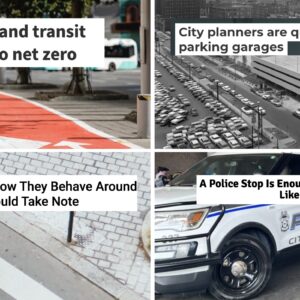As of the latest traffic counts from May of this year, westbound morning peak-hour and eastbound afternoon peak-hour bike traffic is now greater than motorized traffic. That means, traditional downtown traffic (i.e. traffic heading into downtown in the mornings and leaving downtown in the afternoons) has more bikes than cars on Clinton Street, one of our most popular bikeways.
- Morning peak hour was 140 motorized traffic, and 206 bikes (346 total)
- Afternoon peak was 122 motorized traffic, and 210 bikes (332 total)
These counts were taken at 23rd Avenue, in-between the two diverters. Counts at other points on Clinton Street show similar results, with only at 13th Av morning inbound not meeting this criteria (counts were about 44% bike traffic). At nearly every point observed, inbound morning and outbound evening peak bike traffic exceeded motorized traffic.
This is a huge deal. Having more bikes than cars on a city-designated “bicycle priority” route will further encourage more people to ride. Safety in numbers can be a huge boost to ridership, which will even further improve safety. These counts were even taken before the Biketown rollout, so expect these numbers to increase further, as Clinton Street features two Biketown stations.
Feel free to browse the data yourself; here’s a Google Spreadsheet with the data, you can clone it (file->make a copy) if you want to do your own analysis.








Thanks for reading.
BikePortland has served this community with independent community journalism since 2005. We rely on subscriptions from readers like you to survive. Your financial support is vital in keeping this valuable resource alive and well.
Please subscribe today to strengthen and expand our work.
Great news. This is the direction we should be consciously heading on the other major bikeways.
This is great stuff, Adam. Thanks.
It would also be interesting to check back with the neighbors who were convinced the sky would fall, that Woodward would be overrun with spillover car traffic; see how that whole thing turned out.
Does anyone have a read on this?
Thanks! Btw, we got the counts on Woodward a few months ago and it saw total motor traffic of 612 from 190 before the diverter went in; an increase of 422.
I keep missing follow up posts to conversations I’ve subscribed to – Something’s not working with the subscribe function for me, but thanks also for this figure, Adam. A tripling is not nothing, but 600/day is also well below the 1,000/day cutoff PBOT identified as cause for remedial action. What a shame Michael’s no longer on the team – he could have done a great follow up here.
I was actually misinformed on those numbers: those are actually for 32nd Avenue, south of the diverter. Looks like the highest counts on Woodward were at just west of 32nd at 668 vehicles per day.
I was actually misinformed on those numbers: those are for 32nd Avenue, south of the diverter. Looks like the highest counts on Woodward were at just west of 32nd at 668 vehicles per day.
Very cool! The diverters have been really beneficial on Clinton- Looking forwards to the permanent version on 31st!
maybe I’ll ride to work more now… Clinton was always a stressful section both ways…
I have noticed a huge difference in stress now after the diverters have gone in. There are still a few jεrks, but bad encounters with drivers have dropped dramatically from before.
First off, a clarification: the data here show that bikes outnumber cars, but there is no comparison with Clinton before the diverters were installed, right? Is that data available to really evaluate their impact?
Second, I really have to point out that while the diverters are successful at changing traffic flow, their design is kind of terrible (especially the block at Clinton/32nd Ave). The visible cues to cross traffic are awful. At 17th, the long barrier suggests right-of-way to cross traffic on 17th, exactly the opposite of the actual signage – though at least the city finally sandblasted off the stop lines that also suggested Clinton traffic would be stopping. At 32nd, the concrete barriers and big arrow signs are a very effective visual barrier to cross traffic seeing the cyclists for whom they are supposed to stop.
This morning I was driving across Clinton at 32nd. I know that I’m yielding to bikes, and I make my full stop at the sign. I’m doing head checks left and right (twice, actually) and then I slowly start across. Right at that moment, a cyclist emerged westbound from behind the barrier. I was going slow enough to stop short, but it was not a nice moment for either of us. The point is, the cyclist was doing what she was supposed to be doing, and I was looking really carefully, knowing that she could be there, but the barrier completely hid her from my view. In other words, it is functionally a terrible design.
Let me close by pointing out that I spend a lot of time on two wheels on the bike route network, and I know how these intersections work (and I support them in principle). Even so, I find it difficult to do the yielding I know I’m supposed to do when I’m driving, because the designs are so poor. These diverters can’t be seen as a success until the City goes back and designs them so they have good sightlines and visual cues that remind drivers of who yields to whom. In the meantime, I’m just urging folks using Clinton to not cruise through these intersections; if somebody like me who really wants to do the right thing has trouble yielding to you, who knows what will happen with a disinterested (or worse, distracted) driver. It’s not your fault – it’s just really poor layout of the diverters.